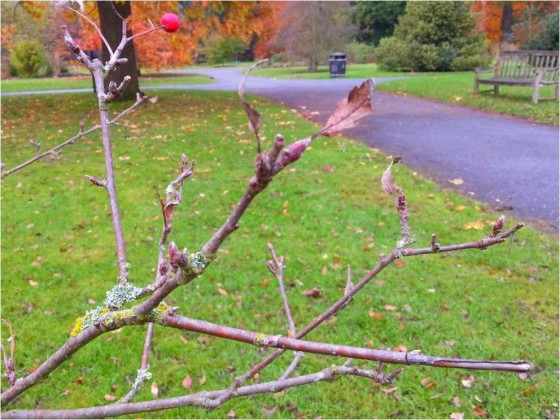Whitebeams (Sorbus spp.) are beautiful trees characterised by white-backed leaves, white blossom produced in the spring and bright red/orange berries in the autumn.
The rarest tree in Wales, UK, is the Ley’s Whitebeam (Sorbus leyana) also known as Cerdin Darren Fach. There are only 17 individuals left in the wild clinging to steep limestone cliff sides at two sites in the Brecon Beacons. Most grow as shrubs with their trunks appressed against rock faces but in more exposed areas they form erect trees. This species is thought to have derived from the Mountain Ash and the Rock Whitebeam. As there are so few individuals of this species in the wild the greatest threat is through trampling, collection of specimens or theft of whole plants.
Two other rare species found in the Brecon Beacons are Sorbus leptophylla and S. minima. There are 113 individuals of S. leptophylla, also known as narrow-leaved Whitebeam, left in the wild and 780 individuals of S. minima, the Least Whitebeam (or Cerdin Wen Leiaf in Welsh). Their populations are probably reduced as a result of quarrying in the area.

S. minima (Royal Botanic Gardens Kew)
A recent genetic study has found 6 new species of Whitebeam in Wales. Some of these species have probably evolved recently; others may have been known for some time but are only now described as a species thanks to modern genetic methods. Two new closely related species S. cambrensis (Welsh Whitebeam) and S. stenophylla (Llanthony Valley Whitebeam) are also endemic to Breconshire, Wales. They both only have around 100 individuals left in the wild and have been given the provisional IUCN conservation assessment of Endangered. Sorbus cuneifolia (Llangollen Whitebeam) and S. stirtoniana (Stirton’s Whitebeam) are another two rare trees endemic to Wales of which there are 240 individuals and 35 individuals known, respectively.
Sorbus x motley, Motley’s Whitebeam, is a new hybrid between Ley’s Whitebeam and Rowan and is an example of evolution in action. There are two saplings of this species found at Coed Penmailard, Brecon and they appear to be different ages so must have arisen independently. The older of these two saplings is thought to have originated from around 1990 after the second Great Storm of 1989. During this storm many Ley’s Whitebeam trees were blown down, the extra light in the woodland allowed seeds in the soil to germinate and grow.
There are many theories as to why these Whitebeam species are so rare. Firstly, the pollen produced by this species is not viable and instead it reproduces asexually, all offspring are identical to the parent tree and thus not well adapted to change. Secondly, these species are heavily grazed by animals. Thirdly, extensive quarrying in the Brecon Beacons has destroyed some of the sites where these species live and has reduced the amount of available habitat. Lastly, many of these species are thought to have evolved only recently. Whitebeams are of evolutionary importance as they provide evidence of a continuing evolutionary process which generates new species.
Nearly all the populations of these rare Whitebeam species are now within Sites of Special Scientific Interest (SSSIs) and ex situ collections of all taxa are held at the National Botanic Garden of Wales.
Please note: The IUCN conservation status illustrated here only applies to Sorbus leyana and S. leptophylla, the other species are as yet not listed on the IUCN Red List.
Did you know?
During the Middle Ages, Yew wood was used to craft long bows and spears as the timber was both strong and elastic. This led to the exhaustion of Yew forests once widespread across Britain.
